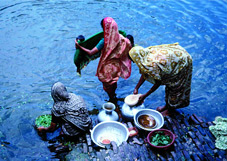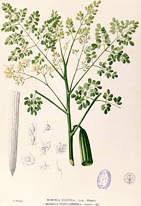Improving Water Quality in Less-Developed Countries

Picture courtesy of Anwar Huq, University of
Maryland Biotechnology Institute, Baltimore,
Maryland, United States.
Technologies that have been developed in the Western world to ensure a safe and sufficient water supply are beyond the means of many low-income communities in developing countries.
Boiling to sterilize the community's water is often not the best solution - wood and charcoal may be scarce and expensive, and boiling takes time. More importantly, boiled water can be re-contaminated easily during storage in open buckets. Rather than wait decades for the provision of piped treated water, individuals and scientists have come up with some low-tech solutions to give people the ability to make their drinking water cleaner now. Below are some examples.
Filtering Water through a Folded Sari
In Bangladesh, women use saris to filter out bacteria from drinking water. The sari needs to be folded so that there are four to eight layers of cloth. The folded cloth is then wrapped over the water pot before water is collected from the river or pond. Laboratory tests have shown that this method removes 99 percent of bacteria.
Once the water is in the pot, the sari is removed, unfolded, rinsed in the pond or river, or in a small amount of the filtered water. It must then be dried in the sun for a couple of hours - a process of natural decontamination that kills off any bacteria trapped in the material.
The sari method is simple, cheap, and, because saris are found in every household in Bangladesh, available to even the poorest of the poor. A study of 133,000 people in 65 Bangladeshi villages showed that when women were taught to use a folded sari to filter drinking water, the incidence of cholera dropped by 48 percent.
Safe Water System (SWS)
In many parts of the developing world, water is collected from outside the home and then held in open storage vessels, where the water may become contaminated by dirty hands, utensils, insects and other animals. Thus, strategies to reduce waterborne disease must consider not only how to purify water when it is being collected, but also how to store it safely.
Scientists from the Centers for Disease Control and Prevention in the United States have developed an inexpensive strategy to improve household drinking water that addresses both of the problems outlined above. It is a simple disinfection and storage system called the Safe Water System (SWS). The system consists of three elements: a bottle of a 0.5% percent sodium hypochlorite solution (the active ingredient in laundry bleach); a 20-litre plastic water jug with a spigot, a narrow opening, and a comfortable handle; and community education.
The sodium hypochlorite solution is a chemical disinfectant that is relatively inexpensive, safe to use, and effective at killing pathogens. It allows an individual to disinfect drinking water immediately after collection. The narrow-mouthed, closed design of the storage vessel greatly reduces the risk of contamination, while the comfortable handle increases the likelihood that the jug will be used. Community education programs encourage use of the system by showing the link between hygiene, clean water, and good health.
According to field trials, the new strategy appears promising; households using the new system had less E. coli contamination of stored water and less diarrhoea than did households that did not use it.

Moringa oleifera - A Natural Coagulant
In Malawi the seeds of the small Asian Drumstick tree (Moringa oleifera) are being used as a primary coagulant to purify household water. The seeds of the Moringa tree contain significant quantities of water-soluble proteins that carry a positive charge. When the crushed seeds are added to raw water, the proteins act like magnets, attracting negatively charged particles, such as clay, bacteria, and other harmful substances in the water. The larger particles, or flocs, that are formed are easily removed by settling. This technology has been found to eliminate up to 99% of bacteria found in water.
Municipal Water Supply
Wells in Rural Areas
Wilderness Areas


